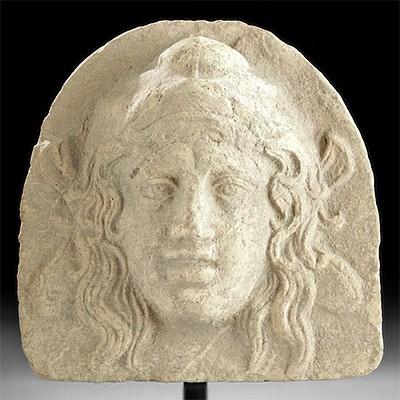Translated Sumerian Clay Cuneiform Foundation Cone
Lot 85
About Seller
Artemis Fine Arts
686 S Taylor Ave, Ste 106
Louisville, CO 80027
United States
Selling antiquities, ancient and ethnographic art online since 1993, Artemis Gallery specializes in Classical Antiquities (Egyptian, Greek, Roman, Near Eastern), Asian, Pre-Columbian, African / Tribal / Oceanographic art. Our extensive inventory includes pottery, stone, metal, wood, glass and textil...Read more
Categories
Estimate:
$1,400 - $2,000
Absentee vs Live bid
Two ways to bid:
- Leave a max absentee bid and the platform will bid on your behalf up to your maximum bid during the live auction.
- Bid live during the auction and your bids will be submitted real-time to the auctioneer.
Bid Increments
| Price | Bid Increment |
|---|---|
| $0 | $25 |
| $300 | $50 |
| $1,000 | $100 |
| $2,000 | $250 |
| $5,000 | $500 |
| $10,000 | $1,000 |
| $20,000 | $2,500 |
| $50,000 | $5,000 |
| $100,000 | $10,000 |
| $200,000 | $20,000 |
About Auction
By Artemis Fine Arts
Feb 27, 2020
Set Reminder
2020-02-27 10:00:00
2020-02-27 10:00:00
America/New_York
Bidsquare
Bidsquare : VARIETY SALE | Antiquities & Ethnographic Art
https://www.bidsquare.com/auctions/artemis-gallery/variety-sale-antiquities-ethnographic-art-4920
Around the world & back in time - be amazed at the treasures you will find. Antiquities from Egypt, Greece, Italy and the Near East, Asian, Pre-Columbian, African / Tribal / Oceanic, Native American, Spanish Colonial, Russian Icons, Fine Art, much more! Artemis Fine Arts info@artemisfinearts.com
Around the world & back in time - be amazed at the treasures you will find. Antiquities from Egypt, Greece, Italy and the Near East, Asian, Pre-Columbian, African / Tribal / Oceanic, Native American, Spanish Colonial, Russian Icons, Fine Art, much more! Artemis Fine Arts info@artemisfinearts.com
- Lot Description
Ancient Near East, Mesopotamia, Sumer, city of Lagash, Neo-Sumerian period, reign of Gudea of Lagash, ca. 2120 to 2090 BCE. A nicely preserved, hand-built clay votive foundation cone bearing a tapered conical body and a broad discoid head. The body is inscribed with twelve columns of cuneiform text formed by pressing a sharpened reed or stick into the still-wet clay prior to firing. Foundation cones like this example - also referred to as dedication pegs or funerary pegs - were inscribed with prayers or praises for specific gods or rulers. When translated this cone reads, "For Ningirsu, the mighty warrior of Enlil, Gudea, governor of Lagash, who built the Eninnu (temple) of Ningirsu, (also) built his Epa, the temple of seven sectors." Size: 4.8" L x 2.6" W (12.2 cm x 6.6 cm)
For a strikingly similar example, please see The Metropolitan Museum of Art, accession number 45.90.
For another strikingly similar example, please see "Beloved by Time: Four Millennia of Ancient Art." Fortuna Fine Arts, Ltd., New York, 2000, pp. 18-19, fig. 28.
Provenance: private J.H. collection, Beaverton, Oregon, USA, acquired in October 2000; ex-Tom Cederlind collection, Portland, Oregon, USA
All items legal to buy/sell under U.S. Statute covering cultural patrimony Code 2600, CHAPTER 14, and are guaranteed to be as described or your money back.
A Certificate of Authenticity will accompany all winning bids.
We ship worldwide and handle all shipping in-house for your convenience.
#153267Repaired from two large pieces across midsection of conical body, with resurfacing and light adhesive residue along break lines. Minor nicks and abrasions to head and body, chip to tip of body, and softening to some inscribed cuneiform characters. Nice earthen deposits throughout. Remaining cuneiform characters are still legible.Condition
- Shipping Info
-
All shipping is handled in-house for your convenience. Your invoice from Artemis Gallery will include shipping calculation instructions. If in doubt, please inquire BEFORE bidding for estimated shipping costs for individual items.
-
- Buyer's Premium



 EUR
EUR CAD
CAD AUD
AUD GBP
GBP MXN
MXN HKD
HKD CNY
CNY MYR
MYR SEK
SEK SGD
SGD CHF
CHF THB
THB














